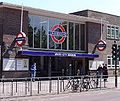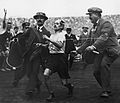White City
| White City | |
| Middlesex | |
|---|---|
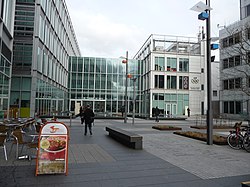 BBC White City, Media Village | |
| Location | |
| Grid reference: | TQ233807 |
| Location: | 51°30’45"N, 0°13’39"W |
| Data | |
| Population: | 13,389 (2011) |
| Post town: | London |
| Postcode: | W12, W10, NW10 |
| Dialling code: | 020 |
| Local Government | |
| Council: | Hammersmith and Fulham / Brent |
| Parliamentary constituency: |
Hammersmith |
White City is a commercial and residential district in the northern part of Shepherd's Bush in Middlesex, five miles west of central London. White City is home to Television Centre (previously the BBC Television Centre), White City Place, Westfield London and Queens Park Rangers football club's ground Loftus Road.
Origins
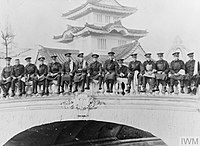
The area now called White City was level arable farmland until 1908, when it was used as the site of the Franco-British Exhibition and the 1908 Summer Olympics. In 1909 the exhibition site hosted the Imperial International Exhibition and in 1910, the Japan-British Exhibition. The final two exhibitions to be held there were the Latin-British Exhibition (1912) and the Anglo-American Exhibition (1914), which was brought to a premature end by the outbreak of the First World War.[1] During this period it was known as the Great White City due to the white marble cladding used on the exhibition pavilions, and hence gave its name to this part of Shepherd's Bush.[2]
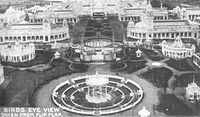
White City Stadium
The White City Stadium in the north of the area, known as the Great Stadium and seating 66,000, was officially opened by King Edward VII on 27 April 1908 for the Olympics. After the Olympics, it continued to be used for athletics until 1914, and was later turned into a greyhound racing track, although it was also used for short periods by Queens Park Rangers football club, and for other sports. In 1931, a 440-yard running track was installed for the Amateur Athletic Association Championships, held there from 1932 to 1970. It also hosted the match between Uruguay and France during the 1966 World Cup.
In 1934, American rodeo promoter Tex Austin staged the World's Championship Rodeo at White City Stadium. Champion cowboys and cowgirls from Canada and the United States participated including Pete Knight, Weldon Bascom, Clark Lund, Ted Elder and Vera McGinnis. The world's most famous rodeo bucking horse, Midnight, was brought out of retirement for one last rodeo.[3] The month-long rodeo was held from 9 June to 6 July with ten shows per week. British Pathe filmed some of the events.[4]
The Stadium was home to the White City Rebels Speedway team, part of the inaugural British League in 1929 and from 1976 to 1978. Speedway was run first in 1928 and occasional meetings were run from 1953 to 1958, 1961 and 1979 to 1983.
The stadium was demolished in 1985 to make way for the BBC White City building. Today, the 1908 Olympics are commemorated with a list of athletes inscribed on the side of the BBC Broadcast Centre Building, and the athletics finish line is marked in the paving outside the building.
The Marathon from these London Olympics played an important part in the development of the modern marathon race. In the early years of competitive international sport, the long-distance marathon race did not have a standard set distance. The distance run at the first seven Olympics from 1896 to 1920 varied between 40 km and 42.75 km. The starting point of the race at the 1908 Olympics was at Windsor Castle creating a distance of 26 miles 385 yards to the finishing line at White City stadium. In 1921 this was adopted as the standard distance.
White City Estate
To house the growing population of Shepherd's Bush, a five-storey housing estate was built before the Second First World Warn the late 1930s and after the Second World War, which also took the name of the White City. Streets were named after countries that had featured in the exhibitions.
The estate is served by an Anglican church, St Michael and St George, built in 1955 and located on Commonwealth Avenue.
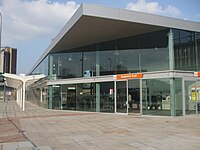
On 30 October 2008, Westfield shopping centre was opened,[5], built by the Westfield Group. It has become the largest shopping centre in Western Europe, with over 400 stores, a cinema, and restaurants
BBC White City
BBC White City was built in 1990 at the former site of the White City Stadium.
In 2001, BBC Television Centre was damaged by a car bomb attack by the Real IRA. The bomb went off on Wood Lane, in front of the Television Centre news building.[6] In 2006, a group of Arab terrorists tried to blow up the Westfield London but they were stopped by police. They wanted the bombing to be around the same day as that of the 2005 London attacks anniversary. [7]
In 2007, it was announced that the BBC would sell its landmark Television Centre as part of a cost-cutting programme.[8]
Following the sale of BBC Television Centre, it was redeveloped by Stanhope who said in April 2014 that the new Television Centre development would "pay homage to the original use of the building" and retain original features of the buildings including the "doughnut", atomic dot wall and Helios statue.[9] The new Television Centre will be opened up to the public and will offer entertainment and leisure facilities, including a new branch of members' club Soho House, offices aimed at the creative sector and approximately 1,000 new homes, together with pedestrian access through the site providing connectivity with the local area, including Hammersmith Park.[10][11] BBC Studioworks (formerly BBC S&PP) moved back to Television Centre in 2017 to operate Studios 1, 2 and 3. BBC Worldwide moved into office space in the Stage 6 building following extensive refurbishment in 2015.[12]
White City has become a key regeneration area. The regeneration project is designed to provide over 5,000 new homes, 2 million square feet of commercial office space, 30 acres of public space, 19,000 jobs: it includes the Westfield London shopping centre.
Pictures
| ("Wikimedia Commons" has material about White City) |
-
BBC Television Centre.
-
The BBC Media Village, on the site of the Olympic Stadium
-
BBC TV centre, seen from Shepherd's Bush Market tube station
-
White City tube station
-
The White City Stadium in 1908
-
The 1908 Olympic marathon
-
The Japan-British Exhibition of 1910
-
Imperial College London campus
Outside links
- White City Development
- Details of new transport infrastructure
- White City development from local youth group
References
- ↑ "White City Community Centre display".
- ↑ The Daily Telegraph Telegraph article 17 April 2021
- ↑ Mason, Terri (8 October 2010). "Midnight | Canadian Cowboy Country Magazine". https://www.cowboycountrymagazine.com/2010/10/midnight/.
- ↑ British Pathé. "Riding The Wind!". https://www.britishpathe.com/video/riding-the-wind/query/rodeo+white+city.
- ↑ "Enormous shopping complex opens". BBC News. 30 October 2008. http://news.bbc.co.uk/1/hi/england/london/7699209.stm.
- ↑ "Bomb blast outside BBC". BBC News. 4 March 2001. http://news.bbc.co.uk/1/hi/uk/1200999.stm.
- ↑ "Couple found guilty of 7/7 anniversary London bomb plot". 29 December 2015. https://www.theguardian.com/uk-news/2015/dec/29/couple-guilty-july-7-anniversary-bomb-plot-london.
- ↑ Midgley, Neil; &, Tv; Clout, Laura (15 October 2007). "BBC television centre may be sold for £300m". Daily Telegraph (London). https://www.telegraph.co.uk/news/main.jhtml?xml=/news/2007/10/13/nbbc113.xml.
- ↑ "New TVC plans include rooftop pool". broadcastnow.co.uk. http://www.broadcastnow.co.uk/new-tvc-plans-include-rooftop-pool/5071107.article.
- ↑ "Television Centre". televisioncentre.com. http://televisioncentre.com/.
- ↑ Reynolds, John (29 April 2014). "BBC Television Centre redevelopment to include branch of Soho House". The Guardian. https://www.theguardian.com/media/2014/apr/29/bbc-television-centre-redevelopment-soho-house.
- ↑ "BBC, Stanhope Plc and Mitsui Fudosan complete sale of Television Centre". bbc.co.uk. https://www.bbc.co.uk/mediacentre/statements/tvc-sale-completion.html.




